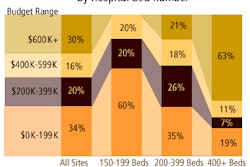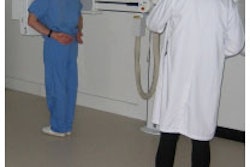As multidetector-row CT (MDCT) becomes more prevalent in cardiac imaging applications, its primary benefit may be as a complementary modality to MR, providing additional information and patient coverage that MR cannot.
In determining whether to use CT angiography (CTA) for ischemic heart disease cases, Dr. Richard White, chairman of the radiology department at the University of Florida-Shands Jacksonville, said that practitioners should consider whether the technique is appropriate for the application.
"We need to ask the question: 'Should we be doing it at all?' When time is of the essence and we suspect an acute myocardial infarction, the patient should be in the cath lab," White said. "If we had critical questions regarding how good the acquisition should be, I think at this point we have to favor MR, because of its ability to get a number of different acquisitions. I think CT has promise, but we have to question the application."
White made his comments at Stanford University's 2006 International Symposium on Multidetector-Row CT in San Francisco, when he reviewed the integration of cardiac MDCT and cardiac MRI in ischemic and nonischemic heart disease.
For example, while CTA has shown very good sensitivity in detecting myocardial infarctions, White said that CTA has "rather limited specificity when compared to the counterpart in delayed-enhancement MRI."
Still, CT and CTA do make valuable contributions in the assessment of a patient's condition. The real advantage of CT in both ischemic and nonischemic heart disease is the ability to image a patient who may not be able to receive an MRI scan because of implanted hardware, such as a defibrillator and other biventricular pacing devices.
In cases of chest discomfort, coronary CTA is gaining popularity and has displaced MR angiography to a degree as an investigational tool. "At this point, we can feel reasonably comfortable with using coronary CTA to detect the likelihood of a suspected lesion," White said.
Although coronary CTA remains limited in its ability to accurately measure the degree of stenosis, it can differentiate between subtotal and total occlusion, as well as normal and insignificantly narrowed conditions, he noted. With the capability, CTA can be used in a complementary diagnostic role to assess a major coronary arterial segment being considered for surgical bypass grafting or an interventional procedure.
Partner modalities
Using MDCT-based coronary CTA to detail coronary artery anatomy and MRI myocardial viability maps can noninvasively provide critical information on obstructive and nonobstructive atherosclerotic lesions, White said. With a common software platform and workstation, modeling of the cardiac chambers based on both MDCT and MRI also can provide proper alignment between coronary CTA data from MDCT and myocardial viability maps from MRI.
"When it comes to head-to-head comparison between CT and MR, either modality could be used to define any transmural infarction," he said. "The delayed-enhancement MR image gives us the direct visualization of the scar zone, but, at the same time, it doesn't quite demonstrate as well the areas of calcification."
MDCT also becomes valuable in cases of contraindications to an MR scan, such as a patient with a defibrillator. MDCT with dynamic reconstructions can be substituted to assess abnormalities of left ventricular configuration and function.
Nonischemic applications
For assessing nonischemic heart disease, MDCT and MRI both allow for the assessment of abnormalities in cardiac chamber volumes and systolic function from dilated cardiomyopathy, White said. In addition, dynamic MRI tissue tagging reveals abnormal regional myocardial mechanics, which may influence a patient's therapeutic planning and eventual outcome.
"We can venture into areas such as hypertrophic cardiomyopathy, but we don't see the flow (with CT) that we would see on dynamic MR," White said. "By tagging, it gives up a sense of the mechanics of the myocardium, and with delayed-enhancement we can see a scar that would indicate severe muscle disease."
The evaluation of adult congenital heart disease is where MDCT has come to play a significant role. "To be able to take a complex case that you know nothing about and within a single breath-hold have an acquisition that you can slice and dice is extraordinary," White said, "and it gets to the point where we might start (an assessment) with CT."
MDCT's ability to show dynamic motion is -- using White's description -- "quite extraordinary," as the modality has proved beneficial in the evaluation of clots in appendages. "Coming with that has been all the interactive, postprocessing power that is so essential, so we can provide the physician with endoscopic views and segmentation of the left atrium, which then can be combined with the actual electrotherapy," he said.
While CT technology has advanced, White said there have been improvements regarding both the global and regional assessment of left ventricular function, but he does not believe it to be the primary purpose to perform a CT scan, but rather a "fringe benefit."
By Wayne Forrest
AuntMinnie.com staff writer
August 22, 2006
Related Reading
More research needed to gauge CTA's benefits, August 1, 2006
Cardiac CTA a no-go zone for some, July 17, 2006
CT angiography detects significant coronary lesions prior to valve surgery, June 8, 2006
MRI characterizes myocardial tissue in all its states, June 2, 2006
Cardiac imaging dazzles, but radiologists can't compete alone, April 10, 2006
Copyright © 2006 AuntMinnie.com



















